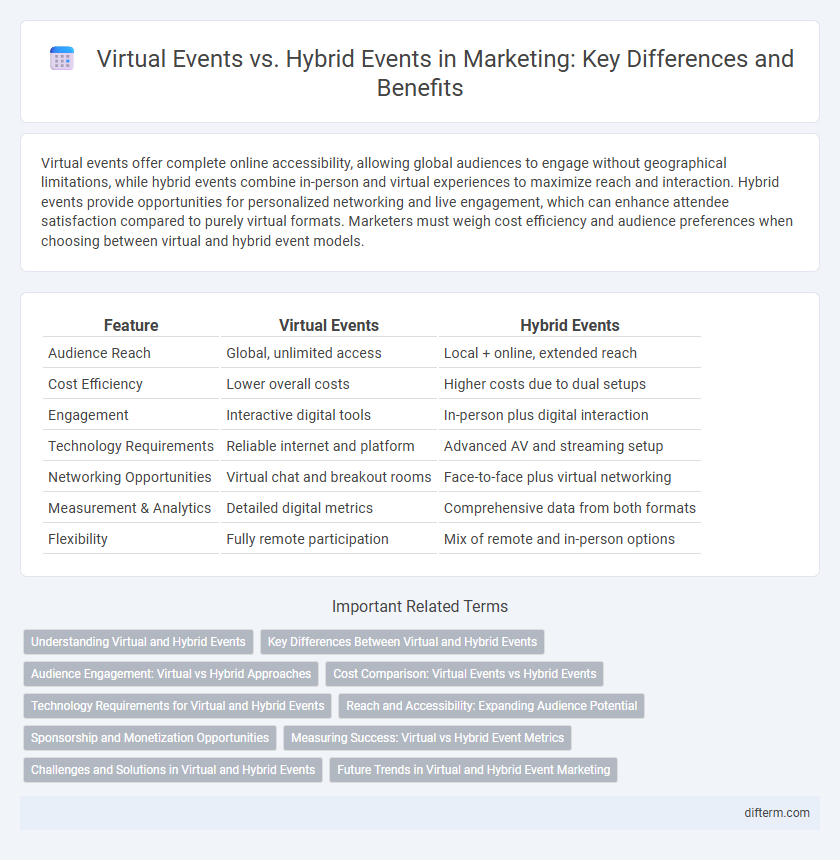Virtual events offer complete online accessibility, allowing global audiences to engage without geographical limitations, while hybrid events combine in-person and virtual experiences to maximize reach and interaction. Hybrid events provide opportunities for personalized networking and live engagement, which can enhance attendee satisfaction compared to purely virtual formats. Marketers must weigh cost efficiency and audience preferences when choosing between virtual and hybrid event models.
Table of Comparison
| Feature | Virtual Events | Hybrid Events |
|---|---|---|
| Audience Reach | Global, unlimited access | Local + online, extended reach |
| Cost Efficiency | Lower overall costs | Higher costs due to dual setups |
| Engagement | Interactive digital tools | In-person plus digital interaction |
| Technology Requirements | Reliable internet and platform | Advanced AV and streaming setup |
| Networking Opportunities | Virtual chat and breakout rooms | Face-to-face plus virtual networking |
| Measurement & Analytics | Detailed digital metrics | Comprehensive data from both formats |
| Flexibility | Fully remote participation | Mix of remote and in-person options |
Understanding Virtual and Hybrid Events
Virtual events utilize fully online platforms to deliver immersive experiences, leveraging tools like live streaming, chat, and virtual exhibitor booths for global audience engagement. Hybrid events combine in-person and virtual elements, enabling simultaneous interaction among physical attendees and remote participants through integrated technologies such as augmented reality, live polling, and networking apps. Understanding the benefits and technical requirements of virtual versus hybrid formats helps marketers tailor event strategies to maximize reach, engagement, and ROI.
Key Differences Between Virtual and Hybrid Events
Virtual events are conducted entirely online, enabling global participation without physical presence, while hybrid events combine in-person attendance with virtual streaming to engage both audiences simultaneously. Key differences include levels of audience interaction, technology requirements, and logistical complexity, with hybrid events demanding more extensive coordination and infrastructure. Data shows hybrid events typically generate higher attendee engagement due to on-site networking opportunities paired with digital accessibility.
Audience Engagement: Virtual vs Hybrid Approaches
Virtual events offer streamlined digital interaction through chat features, polls, and Q&A sessions that drive real-time audience participation. Hybrid events combine in-person energy with virtual accessibility, enhancing engagement by catering to diverse attendee preferences and fostering networking both online and offline. Data shows hybrid events boost overall engagement rates by 30% compared to purely virtual formats due to their blended experiential approach.
Cost Comparison: Virtual Events vs Hybrid Events
Virtual events typically incur lower costs due to the elimination of venue, travel, and on-site staffing expenses, making them a budget-friendly option for marketers. Hybrid events combine in-person and virtual components, which increases costs significantly through venue rental, technology integration, and additional staffing needs. Marketers must weigh the higher investment of hybrid events against their potential for broader engagement and networking opportunities to determine the best value.
Technology Requirements for Virtual and Hybrid Events
Virtual events require robust streaming platforms, high-speed internet, and interactive tools such as chat, polling, and Q&A to ensure seamless audience engagement. Hybrid events demand advanced audiovisual equipment, reliable connectivity for both in-person and remote participants, and integrated event management software to synchronize live and virtual experiences. Investment in scalable cloud infrastructure and cross-platform compatibility enhances the success of both virtual and hybrid event executions.
Reach and Accessibility: Expanding Audience Potential
Virtual events maximize reach by eliminating geographical barriers, allowing global audiences to participate without travel constraints. Hybrid events combine in-person engagement with virtual access, broadening audience potential while providing flexibility and inclusivity. Both formats leverage digital platforms to enhance accessibility, driving higher attendance and diverse demographic engagement.
Sponsorship and Monetization Opportunities
Virtual events offer sponsors targeted digital branding and interactive ad placements with measurable engagement metrics, while hybrid events combine in-person activation with extensive online reach, maximizing visibility across diverse audiences. Hybrid models present multiple sponsorship tiers including on-site booths and virtual product demonstrations, enhancing monetization through multi-channel exposure. Leveraging data analytics from both event formats enables precise ROI tracking, optimizing sponsor investments and unlocking new revenue streams.
Measuring Success: Virtual vs Hybrid Event Metrics
Virtual event metrics often emphasize attendee engagement through real-time chat activity, session attendance rates, and click-through rates on digital content. Hybrid event metrics combine on-site participation data with virtual analytics, including in-person foot traffic, networking interactions, and simultaneous online session engagement. Measuring success in hybrid events requires integrating qualitative feedback from physical attendees with quantitative virtual analytics to provide comprehensive ROI insights.
Challenges and Solutions in Virtual and Hybrid Events
Virtual events face challenges such as limited attendee engagement, technical difficulties, and lack of networking opportunities, which can be mitigated by interactive features like live polls, breakout rooms, and robust tech support. Hybrid events must balance onsite and online experiences, requiring seamless technology integration, real-time content synchronization, and ensuring equal engagement across both audiences. Innovative solutions include using advanced event platforms with AI-driven analytics to tailor content delivery and enhance participant interaction in both virtual and hybrid settings.
Future Trends in Virtual and Hybrid Event Marketing
Virtual events continue to evolve with increased use of AI-driven personalization and immersive technologies like VR to enhance attendee engagement. Hybrid events integrate robust analytics tools to seamlessly blend in-person and virtual experiences, optimizing audience reach and interaction. Future trends emphasize scalability, real-time data utilization, and sustainability, transforming event marketing strategies across industries.
virtual events vs hybrid events Infographic

 difterm.com
difterm.com